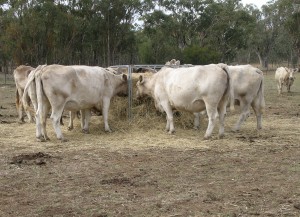If you are a cattle farmer, you may already know that maintaining your cattle herd during the dry seasons can be a challenging task. We will discuss a drought management strategy called dry-lot feeding in this article.
Drought and high temperatures can literally bake your pasture grasses. So if you live in an area where you might have periods of dry weather, you may need to implement some of these drought pasture management strategies for your livestock farm.
Drought is the wild card in any expansion plans and can stop short any rebuilding that might be planned. – BEEF Senior Editor Burt Rutherford | The Beef Magazine
Dry lot Feeding

“Feeding hay” by Cgoodwin – Own work. Licensed under CC BY-SA 3.0 via Wikimedia Commons.
One way to deal with droughts could be dry-lotting during droughts. The idea of raising beef cattle in a dry confined area is gaining popularity among cattle ranchers. This is because beef producers can raise more animals this way, using fewer resources.
Data from North Dakota State University suggests that there is no significant difference in performance of calves and cows whether they were dry-lotted or managed on pasture. It could be an alternative to grazing your cattle in another location. However, you need to check with your state
There are a few factors you should consider
To be able to raise animals in dry feedlots, consider the following factors.
1. Pen size
Pen size can vary based on your soil type and drainage system. Consider giving them more space if you have a mixed group with young and old cows. If possible, keep them in separate pens. In general allow 500-800 square feet per pair. According to University of Nebraska-Lincoln, 28 and 36 inches of bunk space per cow is recommended.
2. Forage
Forage can be expensive and limited during a drought situation. To keep rumens healthy, a general recommendation would be to have at least 0.5% of the cow’s weight on a dry-matter basis as forage. For example if your herd’s average weight is 1,200 pounds, include 6 pounds of dry matter based forage per head per day.
3. Look for cheaper alternatives
To make profit from your cattle herd, you need to find cheaper alternatives to hay for feeding livestock, feed that are nutritious but less expensive. For example, distillers grains, which is a good source of protein, can be used as a cheaper feed alternative to corn.
Dry Lot Cattle
Video Credit: SUNUPTV
P.S: – You could grow your own micro-green grasses that are highly nutritious and easily digestible. Click here to learn about DIY plans for livestock feeding systems. To get a hold of us, please call at 303-495-3705 or Click here to book a meeting. You can also get your Feed in A Box Microgreens (fodder) from us, you will absolutely love it!!
Please leave your questions or comments in the comment box below or visit our Facebook Page and leave your comment there. We’d really appreciate it.
Source: Sustainable Livestock Nutrition
Related articles and resources:
- Basics of Feeding Beef Cattle – Sustainable Livestock Nutrition | Institute of Ecolonomics
- Sustainable Livestock Nutrition & Management Tools | Sustainable Livestock Nutrition
- Tips on Pasture Management & Feeding Heat-Stressed Livestock | Sustainable Livestock Nutrition
- Drought Forces Cattle North To Semi-Confinement | Grazing Systems content from BEEF Magazine
- 4 tips for dry-lotting beef cattle | BEEF Daily
- Drought: An Alternative to Expensive Summer; UNL Beef | UNL Beef | University of Nebraska-Lincoln
- Drylotting Beef Cows – A Drought Management Strategy | UNL Beef | University of Nebraska-Lincoln




I’ve heard of dry lot feeding a few times, and I appreciate the list of things to consider about it. The tip about having the right pen size is an important thing to think about. Without the right equipment, you won’t be able to manage your cattle using any method. It’s always best to think about everything before getting in over your head. Thanks for the article!
Hi Serge Duval,
Thanks for sharing your thoughts. Please read our blogs often and tell your friends about us.
Thanks.